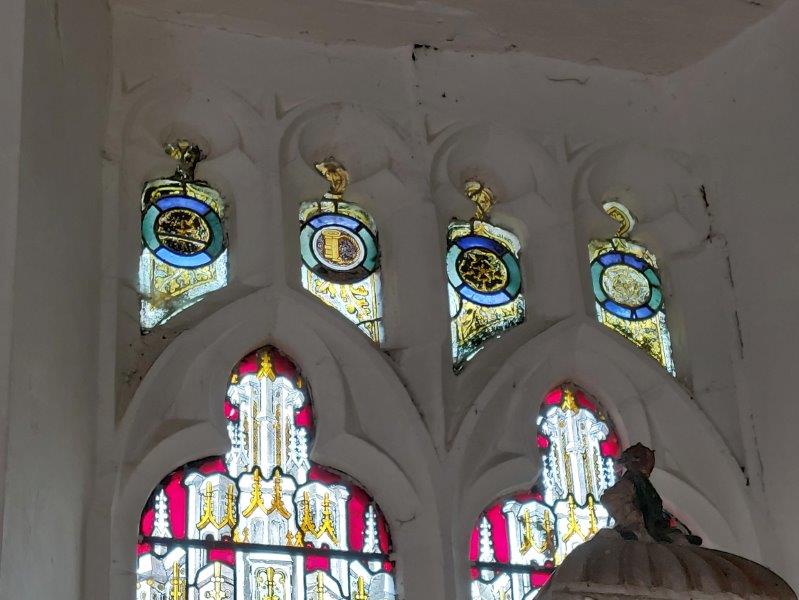On 20th October 1445, Richard, Duke of York returned from war in France and acquired the Manor of Hunsdon. The circumstances of this acquisition are not clear, though John Tyrrell had been appointed to the role of Steward of Clare and Thaxted when Richard was a child, so there may have been a long-established connection with the property through their relationship. By virtue of his birth and the relatively early deaths of his parents, Richard was an extremely wealthy man (in 1436, tax records show he was the richest man in England),[1] and it appears he quickly set about making Hunsdon his own. Records show he was given permission to build a new road across his land from Eastwick to Hunsdon in 1445,[2] and on 5th March 1446, he was granted workers for a major building project (a new manor house) which was licenced in 1447 to include a crenelated tower.[3]
However, he did not stay to see the work completed. In 1448, York transferred the Manor to his former Chamberlain and longtime friend, William Oldhall, and in 1449, moved to Ireland to take up his role as Lieutenant of Ireland. Some historians have suggested that the King wanted him out of the way because he was critical of some of his policies, particularly in relation to the occupation of France, but others point out that York had always been a loyal subject. Indeed, when, in 1453, the King had a period of mental instability and was unable to govern, York, who had returned from Ireland, stepped in to help the King. With the help of the Duke of Norfolk, one John Mowbray (9th descent from Roger de Mowbray, and the first de Mowbray without any claim to Hunsdon), he engineered the arrest and imprisonment of his arch enemy, the Duke of Somerset, who was the King’s closest advisor, and was appointed Protector of the realm until such time as the King regained capacity.
When the King did come to his senses, regrettably for York, he re-appointed Somerset who then excluded York from a council meeting in the spring of 1455. York’s response was to meet the king and Somerset with an army at what was called the First Battle of St Albans – most often regarded to be the first of the Wars of the Roses which raged from 1455 until 1485.
York himself died at the Battle of Wakefield on 30th December 1460, but his eldest son, Edward, was victorious against the King’s forces at the Battle of Mortimer’s Cross in Herefordshire on 2nd February and was proclaimed King (Edward IV) on 4th March 1461 before winning a further decisive victory over forces loyal to Henry at the Battle of Towton in Yorkshire on 29th March 1461. And so it turns out that Hunsdon House, in whatever form it had taken during 1445 and 1449 when the Yorks lived there, had been home to a future King of England. And it is extremely likely that this young royal worshipped in Hunsdon Church next door!
When Edward died in 1483, it was expected that his son, Edward V, then twelve years old, would take the throne, but prior to his coronation, he and all his siblings were declared to be illegitimate and a law was swiftly enacted that passed the title to their uncle, Richard, who had been acting as Protector and who thus became Richard III. Edward and his younger brother, Richard, were held temporarily in the Tower of London, but “disappeared” (assumed murdered – Thomas More records that James Tyrell, i.e. the grandson of John Tyrrell who owned the Manor of Hunsdon in 1423, confessed to killing the princes under the orders of Richard III, and Shakespeare’s play, Richard III, makes the same claim).[4]
And finally, to close another loop in the story, Prince Richard, aged just ten years old when he disappeared, had been married when he was four to a five-year-old girl, Anne de Mowbray, who had sadly died when she was eight. Anne was the only granddaughter of John de Mowbray, the 9th Baron Mowbray, so with her death came the end of the Hunsdon-linked de Mowbray family line started before 1265.[5]
[1] https://www.worldhistory.org/timeline/Richard_Duke_of_York/ accessed 21st August 2024
[2] https://www.british-history.ac.uk/vch/herts/vol3/pp323-332#anchorn37 accessed 21st August 2024
[3] https://dottietales.wordpress.com/2017/03/01/hunsdon-house/#_ednref10 accessed 21st August 2024
[4] https://en.wikipedia.org/wiki/James_Tyrrell accessed 21st August 2024
[5] https://en.wikipedia.org/wiki/Anne_de_Mowbray,_8th_Countess_of_Norfolk accessed 21st August 2024

Comments are closed